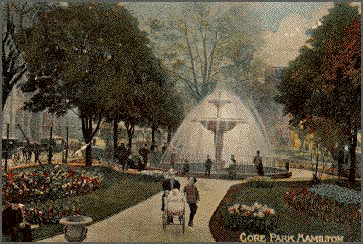
 Official Name:
Official Name:
Up until 1818, both John and King Streets were unmarked slashings in the brush. As this area slowly became recognized as the center of the village, it was proposed to have a square marking the spot.
Gore Park, or the Gore on King Street as it was called in early days, has often been a subject of controversy. George Hamilton's original objective was to create a town centered around a courthouse square. As part of his many large properties, Hamilton owned a piece of land with a strange shape, which he planned to combine with a similar piece held by Nathaniel Hughson to form a town square. Hughson went back on his part of the deal, and Hamilton's triangular "gore" of land remained undeveloped. Used by nearby store owners as a dump, it soon turned into an ugly place to look at.
In 1833 Town Council voted to take over the land and use it as a market. When George Hamilton heard the Council's ideas, he launched a lawsuit to stop them from taking over his property. He won, and Council was forced to give up its plans. The future of the Gore, however, remained undecided.
In 1847, in the midst of a province-wide economic slump, City Council, worried about sources of income, thought about selling the Gore for development. Upon hearing this, Robert Jarvis Hamilton, George Hamilton's son, who had returned to the city from Texas after his father's death in 1836, immediately suggested his rights to the site. In response, Council created a committee to determine the city's legal rights to the Gore.
An agreement was reached between both parties under which the city and Hamilton would split the area and oversee the construction of buildings on both sections. Robert Hamilton was to receive £2,000 for the waiving of his rights to the city's section. Asked to advise on the agreement, the City Solicitor sidestepped the question by referring it to the Solicitor General of Canada. Council, impatiently awaiting the solicitor general's opinion, went ahead and advertised its intentions in the Hamilton Gazette. To its surprise it received letters from 74 residents protesting the subdivision of the Gore into building lots.
The solicitor general's reply arrived in April, 1847. Council was chagrined to hear that it had "no power...to close up a square which this piece of land in question must be considered, and to grant building leases or to build houses on, either with or without the consent of the owner of the soil." The city was warned that if it went forward with its proposal, it could be subject to legal action. Rather than chance this, council bowed, although reluctantly, to the will of the people and withdrew its plan to subdivide the Gore.
Once things had died down, council tried again, putting a notice in the paper that it would be applying to provincial legislature to authorize the construction of a public building on the site. By-law was rescinded by a vote of 10 to 5.
The supporters of building in the site were, however, persistent. Three months later, some of the members of Council recommended the Gore as the site for the new post office. This idea was, not surprisingly, shot down.

The property became a focus of interest six years later as Hamilton scrambled to prepare for the city's first Royal visit. All agreed that the Gore was in great need of improvement and beautification. When Council refused to take quick action on a proposal by the water commissioner to construct a fountain, Isaac Buchanan and several other prominent citizens proposed a joint venture: if the city would put up $1,200 to improve the Gore, they would match it. Ultimately, the fountain, presented to the city by Archibald Kerr, was also placed into the park.
The park soon represented new challenges for the city's fathers. The Parks Committee reported to council that considerable vandalism had occurred in the 'Park on King Street" and that it had ordered "sixteen or eighteen trees to be planted to replace those which have been destroyed by evil disposed persons in consequence of having access to the grounds at all times." To prevent such "wanton destruction" of the property in the future, the committee recommended that the existing turnstiles be removed and "an iron gate placed at each of the four entrances with a lock to each, so that the public may have access only on particular occasions, when policemen should be in attendance to keep order." Clearly, the Gore had begun to evolve from an object of indifference to a precious site to be safeguarded; yet, ironically, it was the citizens of Hamilton, almost solely responsible for the Gore's preservation, who were barred from access to it.
There still, however, remained advocates of the development of Gore. In July 1872 another City Council, not having learned from the experience of its predecessors, decided to erect a new bell tower in the Gore and called for tenders. Local residence rose once again in defense of the Gore, and the tower was constructed on James Street near the market. Eventually, Council bowed to the inevitable and, in April 1873, agreed "that the Park on King Street be formerly laid out and planted with flowers and shrubs, and the fence and fountain newly painted."
Throughout the next decade, the public had one major complaint with Council's management of the park. As one local resident described it, Hamilton was "...the only city we know of which has a locked up park, and we refuse to believe that the character of our people makes it necessary." Not until June 1883 was the park formally open to the public, with the gates unfastened each morning at seven and locked at eight in the evening. The newly-accessible park became an increasingly popular spot for citizens to congregate, whether just for a leisurely stroll or to listen to a summer band concert.
In May 1898, 64 of Hamilton's most prominent businessmen, some with shops facing onto Gore Park, presented a petition to City Council requesting the park to be extended as far east as John Street. Council agreed, and arrangements were made to sod the area and plant flowers. The only objection to this plan came from the officers of the 13th Battalion, who wanted the extension paved for use as a drill field; They received little support for this proposal. At council, Alderman Fredrick Watkins expressed the popular view that the extension of the park was the key to making "the heart of the city a thing of beauty and a joy forever." "Council now had" in Watkin's words, "the chance to do a great good for the women -the mothers of the city and their children." Perhaps it was this appeal to motherhood that carried the day; at any rate, the park extension had passed 12 to 9.
During the 1890s one of the embellishments to the Gore was erected. Following Sir John A. Macdonald's death on June 6, 1891, the Board of trade proposed erecting a memorial to Canada's first prime minister. The statue, cast in bronze, was delivered to Hamilton in October 1893. It was placed in the intersection of King and John Streets. Sir John Thompson, then Prime Minister, and a large party of dignitaries joined 20,000 spectators for the unveiling.
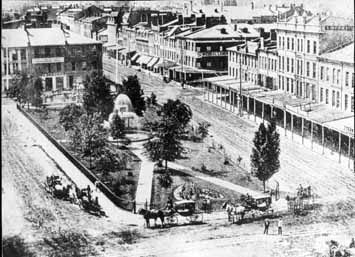
Thompson pushed an electric button, and the covering of the statue dropped. The crowd cheered, the 13th Battalion band played "Hail to the Chief", and the heavens released a torrential downpour on the crowd.
The intersection of King and John Streets proved not to be the best site for the statue. In 1905, Fire Chief Aitchison and his driver, while speeding to a fire, collided with another rig at the intersection and were thrown against the granite base of the monument. The chief died of his injuries. Council members immediately wrote to the board of Parks Management requesting the relocation of the statue to a site in the Gore Park extension. This was done in 1907.
The next suggestion for an addition to the park came in 1900 from the Canadian Club, which proposed placing a flagpole in the park extension. The offer was quickly accepted, and a 150-foot flagpole, in the style of an oil derrick, "made of steel angles and pipe thoroughly galvanized and guaranteed," was ordered at the cost of $165. It was unveiled on Victoria Day, in 1900.
Two years later, a group of prominent citizens calling themselves the "Queen Victoria Memorial Committee" asked permission to erect a statue of Queen Victoria in the park. Council gave qualified approval on the condition that the statue "not interfere with the symmetry of the park," and the committee set to raise the required $10,000. In the presence of the Governor General, Lord Grey, the statue was unveiled and presented to the city on May 25, 1908.
Public access to the park, however, remained restricted to a set period of time each day. This would soon change. In May, 1909, the city received an offer from William Southam, owner of the Hamilton Spectator, to purchase and erect 12 ornamental lamp poles in Gore Park provided the fence was removed. Recognizing the popularity of the proposal, Council agreed to take down the fence and replace it with a cement curb. At long last, the physical barriers to Gore Park had been removed, and it was accessible to the citizens of Hamilton 24 hours a day. In the following decades, the park served as a venue for a wide range of civic activities and celebrations.
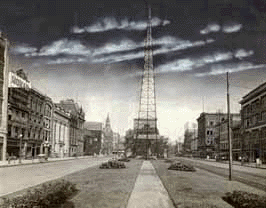 Just as the access issue was solved, the very existence of the park appeared to be threatened. Stanley Mill, one of the city's leading businessmen, proposed constructing a 15-story office building with a public park on the roof of the site of Gore Park. But Mills' offer of $250,000 for the park, even though its assessed value was only $50,000, held little appeal for City Council. Gore Park was as one controller explained it to the local press, "...worth a lot more to the city than any man of firm could pay for it. Any public man who would seriously propose to sell it would be ringing his own death knell."
Just as the access issue was solved, the very existence of the park appeared to be threatened. Stanley Mill, one of the city's leading businessmen, proposed constructing a 15-story office building with a public park on the roof of the site of Gore Park. But Mills' offer of $250,000 for the park, even though its assessed value was only $50,000, held little appeal for City Council. Gore Park was as one controller explained it to the local press, "...worth a lot more to the city than any man of firm could pay for it. Any public man who would seriously propose to sell it would be ringing his own death knell."
The next proposed major expenditure on the park - the underground lavatories near the corner of Hughson and King Streets - became the subject of considerable debate when all the tenders were found to be too high and Council was forced to draw upon the contingency fund to make up the difference. From February 1913 the lavatories would remain in place until the park's remodeling in the 1980s.
In 1921, a combined committee of the Men's and Women's Canadian Clubs requested permission to erect a cenotaph, to honour Hamilton's war dead, in the park extension of the site of the "oil derrick" flagpole. The winning design by W.R. Souter was announced in August 1921, and the cenotaph was officially unveiled by the Governor General, Viscount Byng of Vimy, on 22 May 1923. As with the other structures in the park - the fountain, the Queen Victoria statue, and the Macdonald statue - money for this memorial were was raised solely by private donation and did not cost the tax payers a cent.
As the 1930s began, another proposal was put forth for "goring the Gore". Mayor John Peebles, who previously had gone on record stating that he hoped that within 50 years the park would disappear completely, together with the city engineer, suggested slicing 20-feet from the north side of the park to accommodate a street railway diamond at King and James Streets. Again, public opinion rallied to preserve the park. The Hamilton Herald perhaps put it best, noting that " it would be impossible to compensate the public for the loss of such priceless property. There is nothing that could be done or paid that would make up to the citizens for the loss of such a heritage."
The history of Gore Park in the 1950s was dominated by one issue - the birds! One wonders if Alfred Hitchcock got the inspiration for his famous movie by contemplating what would happen in Hamilton if the birds, "hordes of dirty, noisy starling" in the words of the Spectator, ever sought revenge for the indignities heaped upon them in this decade by politicians and citizens alike. The Parks Board tried a number of solutions including letting of cartridges and firecrackers and banning the feeding of birds in the park, but with little success.
In 1953, a committee of the Board of Control recommended trapping the pigeons in the park. Trappers, under the supervision of the Pigeon Elimination Committee, were to receive a lump sum price of $500 for the first 500 birds trapped and destroyed and $1.20 per bird for the next 500, plus $60 for materials. The whole operation was estimated to take approximately 13 weeks. This plan however, was soon abandoned when it was pointed out that the committee might accidentally hire "an unscrupulous man who might buy pigeons from a huckster at 40 cents each and sell them to the city for a dollar or more."
Instead, the city built a loft-type trap at King and Hughson Streets complete with two females to attract unwary male birds. These decoys were promptly stolen. Recovered two days later, they were "so thoroughly scared and nervous that they...(were) temporarily rendered useless..."
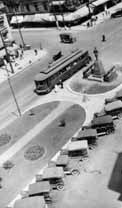
In spite of all these obstacles, it was announce in October that 1,200 pigeons had been successfully removed from the park. They had been humanely trapped, with no use of poison or other noxious substances, then shipped to the "S.P.C.A. gas chamber and painlessly exterminated." The pigeon population appeared to be on the decline. The next problem proved to be a greater challenge: the starling. Attempts to scare them away with squawk boxes, and carved wooden owls hung from trees and by broadcasting recorded warning cries were largely unsuccessful. Finally, in 1954, extreme measures were attempted. In January, 122 hunters armed with shotguns downed some 2,500 birds. In early February, 50 gunners felled several thousand more birds.

Additional shoots were planned twice a week until the end of April, at which time it was hoped that most of the birds would have been eradicated. But this according to an expert from the Royal Ontario Museum, was an overly optimistic assessment: with the starling population of Hamilton estimated at over 2,000,000, he calculated that it would take "eight years, shooting twice a week, to kill off the flock if the birds did not continue to breed."
Members of the public began to make inventive suggestions. The city, in desperation, resorted to feeding the birds grain soaked with whiskey in the hope that they would become intoxicated and thus be easier to catch and gas. Unfortunately, as one local reporter noted, the birds "..did not topple over but flew around the park ;peppily if somewhat, erratically. They finally went up to the building and slept it off and did not come back."
Solving the "bird problem" was the major preoccupation in the 1950s: Still, other things also were happening in the park. The old fountain installed for the Royal visit in 1860 was condemned as unsafe and removed to make way for three saucer-shaped fountains donated by the Kinsmen. As well, a new steel flagpole was donated to the city by Dofasco and erected in the park.
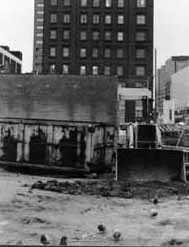 In the 1960's, it was decided that rather than just undergoing occasional cosmetic improvements, Gore Park needed a master plan. Considerable controversy surrounded the proposed changes, particularly after the trees in the park were removed for construction in 1983. This is known as "the Gore Park Chain Saw Massacre" which is part of "the Gore Park Blunder"- a series of several false starts and redesigned plans. The outcry that City Council received for cutting down the trees in the park was nothing compared to what they got for attempting to erect two cement block buildings. Renovations to the park and the adjoining railway were finally completed in November 1984 at the cost of $2.5 million.
In the 1960's, it was decided that rather than just undergoing occasional cosmetic improvements, Gore Park needed a master plan. Considerable controversy surrounded the proposed changes, particularly after the trees in the park were removed for construction in 1983. This is known as "the Gore Park Chain Saw Massacre" which is part of "the Gore Park Blunder"- a series of several false starts and redesigned plans. The outcry that City Council received for cutting down the trees in the park was nothing compared to what they got for attempting to erect two cement block buildings. Renovations to the park and the adjoining railway were finally completed in November 1984 at the cost of $2.5 million.
A reproduction based on the old (and very popular) Victorian fountain is scheduled for installation in October of 1996. This restoration, being done in during Hamilton's sesquicentennial year, should definitely improve the overall beauty of the park.
Certainly, controversy has been no stranger to Gore Park. For more than a century and a half, the existence of this public space in the center of the downtown has been vigorously defended by generations of Hamiltonians, who have come to perceive the park as a "green oasis in a desert of asphalt". Gore Park has been, and remains, integral to the heart of Hamilton.
More on Gore:
1830s: the park was a wood and grain market, and was not very pretty as it was the dumping ground for the local stores
1860s: The western section was turned into an elegant park while the eastern section was left unattended and became an unattractive cab stand.
1900s: At the turn of the century the park was extended, the cab stand removed and was turned into a beautiful garden featuring ornamental flower beds, manicured lawns, and smooth walk ways - this transformation was known as "Galbreaith's Folly" after Newton D. Galbreaith an active community member who was largely responsible for these improvements in the park.
1912 (Jan): Underground lavatories were installed where they remained for 72 years
1940's: Members of the Board of Control approved a model of an English Public Air Raid Shelter, to be built in the park by the Hamilton Home Defense Corp.'s - the shelter never materialized but it was planned to collect admission in support of the war effort.
Name: According to the Shorter Oxford English Dictionary has several definitions, all of which, at one time or another, might have applied to this particular piece of land.
1) Dung, filth of any kind
2) Blood in the thickening state that follows effusion. i.e. "Blood shed in carnage"
3) a triangular piece of land
4) to pierce or wound
